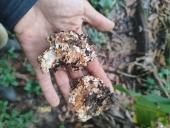Hmm, I'm not 100% sure what you have Ronaldo, but I think the black objects could be larval galls from the midge (fly) known as
Agathomyia wankowiczii, which lays its eggs on the fruiting body of the artists's conk. Check out this photo from wikipedia:
https://en.wikipedia.org/wiki/Ganoderma_applanatum#/media/File:Ganoderma_applanatum03.jpg
At any rate, whatever it is, it certainly doesn't look very appetizing!!! :)
But if I were you and had an interest in medicinal fungi, I would search that area for younger and healthier looking specimens of that same fungus. They also might display the staining response better for better identification. A spore print should reveal rusty brown spores, which often coat the cap of the artist's conk in a fine dust, which can be seen in the above photo.
Thank you for posting. Because I read the wikipedia article, now I know that the artist's conk can be made into a soup, not just tea. I learn new stuff every day at permies...










